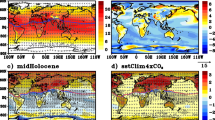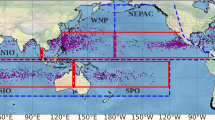Abstract
The interannual variability of the South Pacific Convergence Zone (SPCZ) and its influence on tropical cyclone (TC) genesis in the South Pacific are investigated using observations and ERA40 reanalysis over the 1979–2002 period. In austral summer, the SPCZ displays four typical structures at interannual timescales. The first three are characterized by a diagonal orientation of the SPCZ and account for 85% of the summer seasons. One is close to climatology and the other two exhibit a 3° northward or southward departure from the SPCZ climatological position. In contrast, the fourth one, that only encompasses three austral summer seasons (the extreme 1982/1983 and 1997/1998 El Niño events and the moderate 1991/1992 El Niño event), displays very peculiar behaviour where the SPCZ largely departs from its climatological position and is zonally oriented. Variability of the western/central Pacific equatorial sea surface temperature (SST) is shown to modulate moisture transport south of the equator, thereby strongly constraining the location of the SPCZ. The SPCZ location is also shown to strongly modulate the atmospheric circulation variability in the South Pacific with specific patterns for each class. However, independently of its wide year-to-year excursions, the SPCZ is always collocated with the zero relative vorticity at low levels while the maximum vorticity axis lies 6° to the south of the SPCZ position. This coherent atmospheric organisation in the SPCZ region is shown to constrain tropical cyclogenesis to occur preferentially within 10° south of the SPCZ location as this region combines all the large-scale atmospheric conditions that favour the breeding of TCs. This analysis also reveals that cyclogenesis in the central Pacific (in the vicinity of French Polynesia) only occurs when the SPCZ displays a zonal orientation while this observation was previously attributed to El Niño years in general. Different characteristics of El Niño Southern Oscillation (ENSO)-related Pacific equatorial warming are shown to impact differently on the SPCZ position, suggesting that for regional scales, such as the South Pacific, the SPCZ classification is more appropriate than a simple ENSO index to characterize TC interannual variability. These findings suggest that forecasting the strength of El Niño through SST variations in the eastern Pacific may not be sufficient to accurately predict cyclogenesis in the South Pacific, especially east of the dateline.















Similar content being viewed by others
Notes
The same analysis performed with the eastern boundary at 120°W and 140°W yields very similar results.
Genesis is defined as the first position of a Tropical Depression in the JTWC database that will develop 1-min averaged winds >17 m/s.
References
Adler RF, Huffman GJ, Chang A, Ferraro R, Xie P, Janowiak J, Rudolf B, Schneider U, Curtis S, Bolvin D, Gruber A, Susskind J, Arkin P (2003) The version 2 Global Precipitation Climatology Project (GPCP) monthly precipitation analysis (1979-present). J Hydrometeor 4:1147–1167
Ashok K, Behera SK, Rao SA, Weng H, Yamagata T (2007) El Niño Modoki and its possible teleconnection. J Geophys Res 112:C11007. doi:10.1029/2006JC003798
Basher RE, Zheng X (1995) Tropical cyclones in the Southwest Pacific: spatial patterns and relationships to southern oscillation and sea surface temperature. J Clim 8:1249–1260
Caron LP, Jones CG (2008) Analysing present, past and future tropical cyclone activity as inferred from an ensemble of coupled global climate models. Tellus 60A:80–96
Chan SC, Evans JL (2002) Comparison of the structure of the ITCZ in the west Pacific during the boreal summers of 1989–93 using AMIP simulations and ECMWF reanalysis. J Clim 15:3549–3568
Chand SS, Walsh KJ (2009) Tropical cyclone activity in the Fiji region: spatial patterns and relationship to large scale circulation. J Clim 22:3877–3893. doi:10.1175/2009JCLI2880.1
Chu PS (2004) ENSO and tropical cyclone activity. Hurricanes and typhoons, past, present and future. Columbia University Press, New York, pp 297–332
Emanuel KA, Nolan DS (2004) Tropical cyclone activity and global climate. In: Proceedings of the 26th conference on hurricanes and tropical meteorology. American Meteorological Society, Miami, FL, pp 240–241
Evans JL, Allan RJ (1992) El Niño/southern oscillation modification to the structure of the monsoon and tropical cyclone activity in the Australasian region. Int J Clim 12:611–623
Folland CK, Renwick JA, Salinger MJ, Mullan AB (2002) Relative influence of the interdecadal Pacific oscillation and ENSO on the South Pacific Convergence Zone. Geophys Res Lett 29:1643. doi:10.1029/2001GL014201
Gouriou Y, Delcroix T (2002) Seasonnal and ENSO variations of sea surface salinity and temperature in the South Pacific Convergence Zone during 1976–2000. J Geophys Res 107:8011. doi:10.1029/2001JC000830
Gray WM (1979) Hurricanes: their formation, structure and likely role in the tropical circulation. In: Shaw DB (ed) Meteorology over the tropical oceans. Roy Meteor Soc, London, pp 155–218
Harrison DE, Vecchi GA (1999) On the termination of El Niño. Geophys Res Lett 26(11):1593–1596
Hastings PA (1990) Southern Oscillation influence on tropical cyclone activity in the Australian/south-west Pacific region. Int J Climatol 10:291–298
Holland GJ, McBride JL, Nicholls N (1988) Australian region tropical cyclones and the greenhouse effect. In: Greenhouse planning for climate change, pp 438–455
Jourdain NC, Marchesiello P, Menkes CE, Lefevre J, Vincent EM, Lengaigne M, Chauvin F, Royer JF (2009) Mesoscale simulation of tropical cyclones in the South Pacific: climatology and interannual variability. J Clim (submitted)
Kiladis GN, Storch HV, Loon HV (1989) Origin of the South Pacific Convergence Zone. J Clim 2:1185–1195
Kim HM, Webster PJ, Curry JA (2009) Impact of shifting patterns of pacific ocean warming on north Atlantic tropical cyclones. Science 325:77–80. doi:10.1126/science.1174062
Kuleshov Y, Qi L, Fawcett R, Jones D (2008) On tropical cyclone activity in the Southern Hemisphere: trends and the ENSO connection. Geophys Res Lett 35:L14S08. doi:10.1029/2007GL032983
Larkin NK, Harrison DE (2002) ENSO warm (El Niño) and cold (La Niña) event life cycles: ocean surface anomaly patterns, their symmetries, asymmetries, and implications. J Clim 15:1118–1140
Lengaigne M, Vecchi GA (2009) Contrasting the termination of moderate and extreme El Niño events in coupled GCM. Clim Dyn. doi:10.1007/s00382-009-0562-3
Lengaigne M, Boulanger JP, Menkes C, Spencer H (2006) Influence of the seasonal cycle on the termination of El Niño events in a coupled general circulation model. J Clim 19:1850–1868. doi:10.1175/JCLI3706.1
Lintner BR, Neelin JD (2008) Eastern margin variability of the South Pacific Convergence Zone. Geophys Res Lett 35:L16701. doi:10.1029/2008GL034298
Menkes C, Lengaigne M, Marchesiello P, Jourdain NC, Vincent EM, Lefevre J, Chauvin F, Royer JF (2009) Comparison of cyclogenesis indices on seasonal to interannual time scales (in preparation)
Nicholls N (1985) Predictability of interannual variations of Australian seasonal tropical cyclone activity. Mon Weather Rev 113:1144–1149
Ramsay HA, Leslie LM, Lamb PJ, Richman MB, Leplastrier M (2008) Interannual variability of tropical cyclones in the Australian region: role of large-scale environment. J Clim 21:1083–1103. doi:10.1175/2007JCLI1970.1
Revell CG, Goulter SW (1986) South Pacific tropical cyclones and the southern oscillation. Mon Weather Rev 114:1138–1145
Reyment RA, Jörekog KG (1993) Applied factor analysis in the earth sciences, 2nd edn. Cambridge University Press, London, p 371
Royer JF, Chauvin F (2009) Response of tropical cyclogenesis to global warming in an IPCC AR-4 scenario assessed by a modified yearly genesis parameter. In: Elsner JB, Jagger TH (eds) Hurricanes and climate change. Springer, Berlin, pp 213–234
Royer JF, Chauvin F, Timbal B, Araspin P, Grimal D (1998) A GCM study of the impact of greenhouse gas increase on the frequency of occurrence of tropical cyclones. Clim Change 38:307–343
Spencer H (2004) Role of the atmosphere in seasonal phase locking of El Niño. Geophys Res Lett 31:L24104. doi:10.1029/2004GL021619
Takahashi K, Battisti DS (2007) Processes controlling the mean tropical Pacific precipitation pattern. Part II: the SPCZ and the southeast Pacific dry zone. J Clim 20:5696–5706. doi:10.1175/2007JCLI1656.1
Trenberth KE (1976) Spatial and temporal variations of the southern oscillation. Q J R Meteorol Soc 102:639–653
Trenberth KE, Smith L (2006) The vertical structure of temperature in the tropics: different flavors of El Niño. J Clim 19:4956–4970
Vecchi GA (2006) The termination of the 1997–98 El Niño. Part II: mechanisms of atmospheric change. J Clim 19:2647–2664
Vincent DG (1994) The south Pacific convergence zone (SPCZ): a review. Mon Weather Rev 122:1949–1970
Wang G, Hendon HH (2007) Sensitivity of Australian rainfall to inter-El Niño variations. J Clim 20:4211–4226
Ward JH (1963) Hierarchical grouping to optimize an objective function. J Am Stat Assoc 58(301):236–244
Xie P, Arkin PA (1997) Global precipitation: a 17-year monthly analysis based on gauge observations, satellite estimates, and numerical model outputs. Bull Am Meteorol Soc 78:2539–2558
Yin X, Gruber A, Arkin PA (2004) Comparison of the GPCP and CMAP merged gauge-satellite monthly precipitation products for the period 1979–2001. J Hydrometeorol 5:1207–1222
Acknowledgments
This work was supported by the French “Agence Nationale de la Recherche” (ANR) through the programme Cyclones&Climat ANR-06-VULN-002-01. The authors would like to thank ECMWF for making the ERA40 reanalyses available, the Joint Typhoon Warning Center (JTWC) and the National Hurricane Center for the use of their TC best track data as well as the U.K. Met. Office for use of the HadISST dataset. We acknowledge three anonymous reviewers and Daniel Nethery for their useful comments, which lead to improvements to the present manuscript.
Author information
Authors and Affiliations
Corresponding author
Appendix
Appendix
1.1 Details on the calculation of the convective seasonal genesis parameter
Royer et al. (1998) modified the gray convective seasonal parameter index (Gray 1979) to avoid the use of fixed threshold of SST, which prevented it from being used in GCM climate simulations. They suggested replacing the thermal potential with a convective potential C pot directly linked to the convective precipitation of the model:
Here:
-
f is the Coriolis parameter (in 10−5 m s−1),
-
\( I_{\varsigma } = \varsigma_{\text{r}} .{\frac{f}{\left| f \right|}} + 5 \) where ζr is the low level relative vorticity at 950 hPa (in 10−6 s−1),
-
\( I_{\text{S}} = \left( {{\frac{\delta V}{\delta P}} + 3} \right)^{ - 1} \) is the inverse of the vertical shear of the horizontal wind between 950 and 200 hPa, (in m s−1/750 hPa),
-
Pc is the convective precipitation term of the model,
-
k is a constant dependent on the model.
Rights and permissions
About this article
Cite this article
Vincent, E.M., Lengaigne, M., Menkes, C.E. et al. Interannual variability of the South Pacific Convergence Zone and implications for tropical cyclone genesis. Clim Dyn 36, 1881–1896 (2011). https://doi.org/10.1007/s00382-009-0716-3
Received:
Accepted:
Published:
Issue Date:
DOI: https://doi.org/10.1007/s00382-009-0716-3




